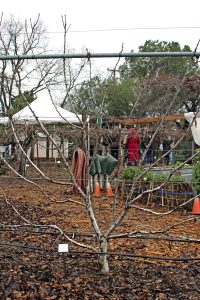Pruning season is here. On Saturday, February 3, UCCE Master Gardeners in Tuolumne County will open their garden (251 Barretta Street, Sonora) for demonstrations on fruit tree, fig, and rose pruning. In advance of Open Garden Day (the garden opens at 10:00 am with demonstrations starting at 10:30), we offer tips on fruit tree pruning.
Winter is an appropriate time to prune fruit trees (except for apricots*). The bare tree provides a clear view of branches and structure. Learn the difference between fruiting wood and vegetative growth. A great chart, https://anrcatalog.ucanr.edu/pdf/8057.pdf, tells where fruiting buds are located on various kinds of fruit trees and how much to prune. Use a ladder. To avoid damage or broken branches, do not climb the tree or pull branches toward you. Try not to remove more than twenty-five percent of the tree canopy in a single year. Severe pruning can shift the tree from fruit production to growth.
Walk around your tree and look for weak, dead, diseased or crossing branches. Also, look for “suckers” growing from the base of the tree. Remove these branches and sprouts first, using sharp pruning shears, loppers, or small saw, depending on the size of the wood.
No two people prune in the same way. The late Chuck Ingels, University of California Farm Advisor, said, “There are many ways to train and prune deciduous fruit trees, and no single method is right for all situations and needs.” Do not be afraid to make mistakes. A healthy tree will outgrow any “errors” you might make.
Think of the final shape you want for your tree, usually a scaffold of 3 to 4 main branches in the shape of a vase or wine glass for good air circulation.
Remember that a cut encourages growth from the bud just below the cut. Choose a bud that faces in the direction you want new growth to occur. Cut cleanly at approximately a forty-five-degree angle about one quarter of an inch above the selected bud. The forty-five-degree angle allows water to drain off the cut surface, reducing the possibility of rot. DO NOT LEAVE A STUB! A long dead stub above a bud provides an excellent entry point for borers. If you are removing a branch back to the trunk, look for the rounded “collar” at the base of the branch and cut just outside its outer edge, not leaving a stub. The intact bark branch collar allows the tree to “roll” tissue over the wound to seal off the injury.
Remove vigorous upright shoots (“water sprouts”) and most competing branches growing straight up into the tree. Horizontal branches are more fruitful.
If you have peaches and nectarines, remove fifty percent of last year’s growth. For figs, apples, pears, plums and apricots remove twenty to thirty percent of last year’s growth. Remove all leaves, old fruit or failed blossoms. Rake the area thoroughly to be sure no insect eggs or diseased material is left around the tree. To protect your tree from sunburn and borers (especially in winter) paint the trunk of the tree with a fifty-fifty mix of interior white latex paint and water.
For more information, go to UC Agriculture and Natural Resources free publications at: https://anrcatalog.ucanr.edu/Items.aspx?search=Fruit%20Tree%20Pruning.
* Note: apricots are susceptible to a branch-killing disease called eutypa dieback; the disease organism is carried into pruning cuts by splashing rain or irrigation. Prune apricots after harvest in July and August when six weeks of dry weather can be predicted.
Jack Bennett has been a University of California Cooperative Extension Master Gardener in Tuolumne County since 2006.

